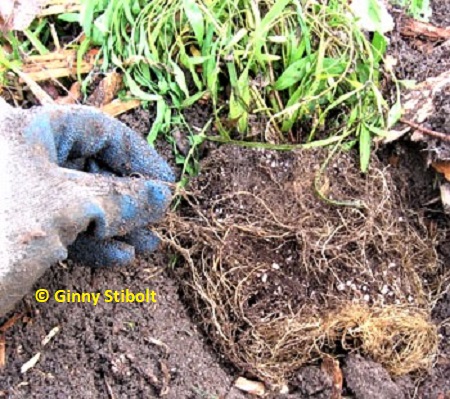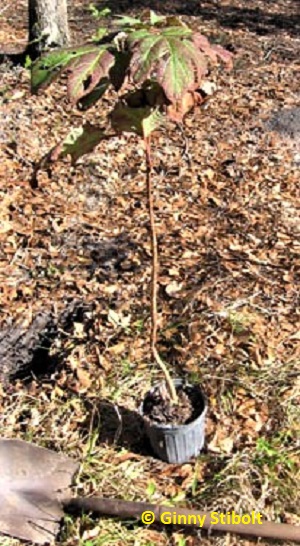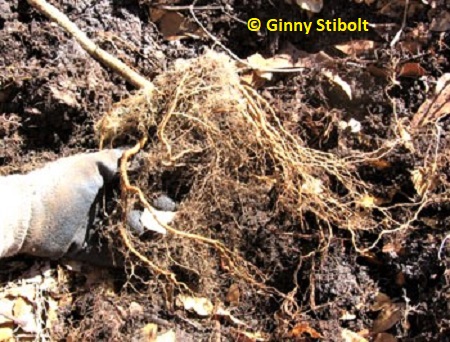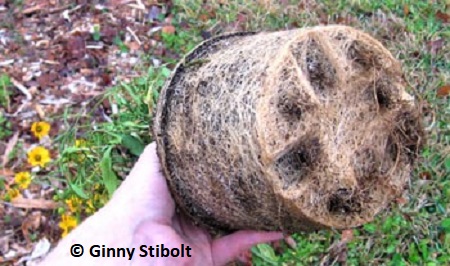Adventures of a Transplanted Gardener |
||||
Pot bound!
| ||||
 |
There were two separate clumps growing in the pot, so I pulled them apart trying to keep as much of the root as possible. The soil in the pot is expendable, though. Any nutrients in this potting mix will have been used up when a plant is in this condition.
<< Once the plants were in their holes, I teased the roots out and spread them in the planting hole. When transferring a plant from a pot to a garden, make sure the plant is no deeper than the surrounding soil.
I filled in with the garden soil. In this front bed the soil has been mulched for a couple of years and is in pretty good shape. I built a berm of soil about seven or eight inches away around the plant to form a water-holding saucer. I added a shovelful of compost into the planting area and then watered each plant with a whole three-gallon watering can right after planting and I watered again late in the afternoon. Rain was forecast for the next day, but if it hadn't come, I would have watered the next day, too. I'll continue to water for the next week or so. I also picked off all the flowers to reduce the strain on the plant.
In 1991, the genus Coreopsis was designated as the Florida state wildflower. Thirteen species of Coreopsis occur in Florida, most of them are native. These are annuals or short-lived perennials and are widely used in roadside plantings. I will gather the seeds and sow them into our meadows to see where they do best.
 |
Oakleaf hydrangea
I also bought an oakleaf hydrangea (Hydrangea quercifolia) that was in dire need of a new home. It was four feet tall, but it was in an itty-bitty one-gallon container and its roots were growing out the bottom. In this case I didn't even try to coax the plant out of its pot; I made a vertical slice down one side of the pot and peeled it away from the root ball.
Again, I teased the roots out into long strands and spread them out in a radiating pattern in the wide planting hole. When planting container-grown trees and shrubs, rinse away potting soil. and don't add any amendments to the soil. Use only the soil that occurs naturally in the area. This encourages the roots to spread out.
The old gardeners' tale about planting a $5 tree in a $25 hole is wrong. Enriching the soil in the planting hole creates a situation where it is unlikely that the roots would grow out and away from the tree. When roots don't radiate from the tree, then the tree is more likely to blow over and it's less likely to be drought tolerant.
 |
<< These roots were pretty long, so I dug a wide shallow
hole. I made sure that the hydrangea was planted no deeper than
it was in its pot. Then I built a water-holding saucer around
the tree with a berm of soil. As above, I used a whole three-gallon
watering can on this plant right after planting and then again late
in the afternoon. I'll continue watering this and the other woody plants
I bought for a few months because they need more attention for long-term
success.
Oakleaf hydrangea is native to Florida's panhandle area and it prefers a sweeter soil than the acidic soil we have here under the oaks. I will lay some eggshells and sprinkle some powdered quicklime around root area.
Be ruthless
If you find yourself dealing with a pot bound plant, be ruthless. While it's a shock to a plant to be treated like this, if you just plop the whole pot bound mass into a planting hole, it will take much longer to adjust to its new location and will be more likely to die when the nutrients in the potting soil are spent. Take your time and be thorough in releasing and spreading the roots of these unfortunates, supply enough water, and soon you'll have a living, thriving plant for your garden.
(Update: The oakleaf hydrangea filled out and became part of the ecosystem in the wooded area that was the front meadow.)
Resources:
- University of Florida professor of horticulture, Ed Gilman's website
has details on planting, pruning, and otherwise caring for your woody
plants: http://hort.ifas.ufl.edu/woody/.
- The Association of Florida Native Nurseries has a locator for nurseries
near you that specialize in native plants: www.plantrealflorida.org.
- You can learn about root rinsing and other garden myths at Linda Chalker-Scott's
website: www.informedgardener.com
Ginny Stibolt is a life-long gardener, a botanist, a naturalist, and a garden writer. You may contact her or read more of her articles posted on her website: www.greengardeningmatters.com.
Copyright Ginny Stibolt


